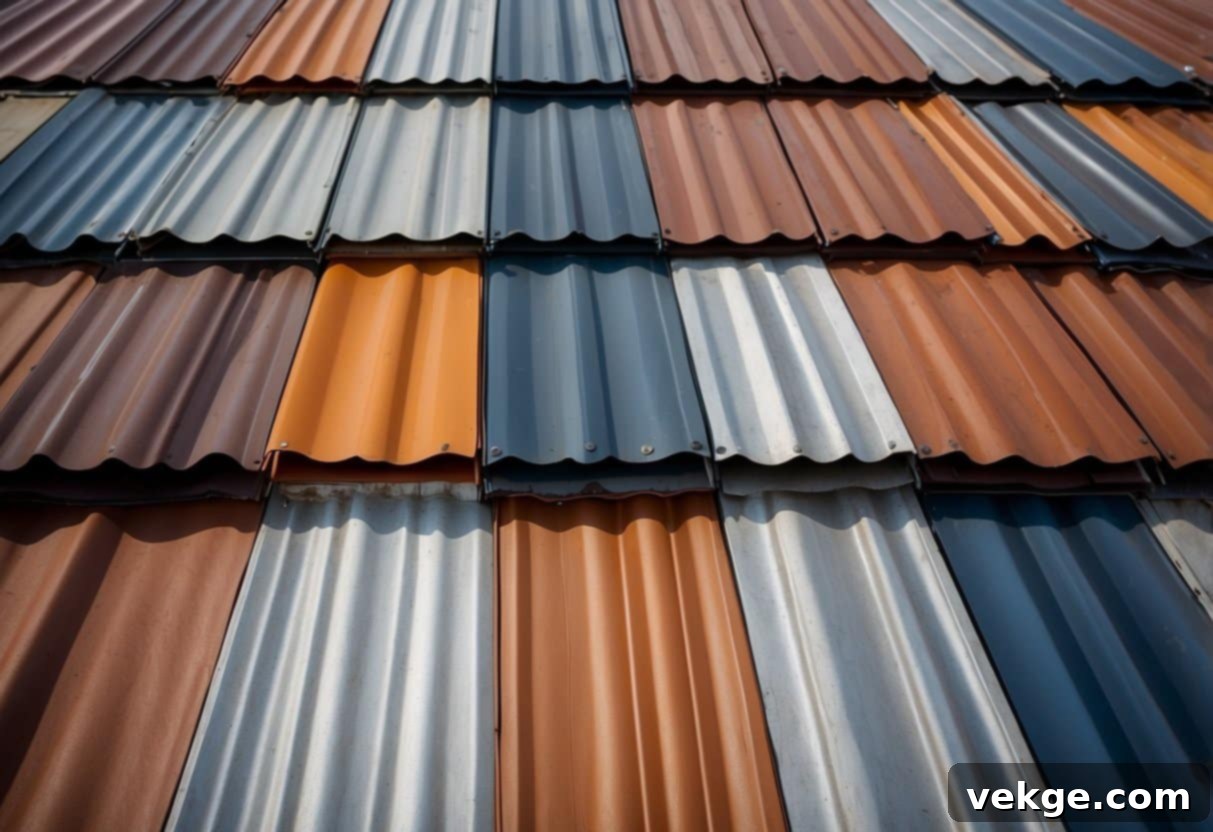Unlocking the Potential of Metal Roofing: Your Comprehensive Guide to Types, Benefits, and Selection
Choosing the ideal roofing material is a critical decision for any homeowner or business, impacting everything from energy efficiency to curb appeal and long-term maintenance. Among the many options available, metal roofs stand out as a premier choice, offering an exceptional blend of durability, energy efficiency, and aesthetic versatility. Far from the utilitarian look of yesteryear, today’s metal roofing comes in a sophisticated array of styles and materials, each with unique characteristics and benefits, making them suitable for diverse architectural designs and climates.
This comprehensive guide delves into the nine distinct types of metal roofs, providing you with the knowledge to make an informed decision that aligns with your specific needs, budget, and design preferences. Whether you’re seeking a sleek, modern aesthetic or a traditional, timeless look, understanding these options is the first step toward selecting the best metal roof for your property.
Why Choose a Metal Roof? Understanding the Core Benefits
Before exploring the specific types, it’s essential to understand the overarching advantages that make metal roofing a superior choice for many. These benefits contribute to both the immediate value and the long-term performance of your property:
- Exceptional Durability and Longevity: Metal roofs are renowned for their incredible lifespan, often lasting 40-70 years or even more, significantly outperforming traditional asphalt shingles. They are highly resistant to fire, rot, mildew, and insects.
- Superior Weather Resistance: Designed to withstand extreme weather conditions, metal roofs can handle high winds, heavy snow loads, and torrential rain with remarkable resilience. Certain types also offer excellent hail resistance.
- Energy Efficiency: Many metal roofs are considered “cool roofs” due to their ability to reflect solar radiant heat, which can reduce cooling costs by 10-25%. This benefit is further enhanced by specific coatings and colors.
- Environmental Friendliness: Metal roofs are often made from a high percentage of recycled content and are 100% recyclable at the end of their long life, minimizing landfill waste.
- Low Maintenance: Once installed, metal roofs require minimal maintenance, typically limited to occasional inspections and cleaning of gutters. They don’t absorb water, which prevents common issues like moss and algae growth.
- Enhanced Aesthetic Appeal: With a vast array of colors, finishes, and profiles, metal roofing can complement any architectural style, from classic to contemporary, boosting your home’s curb appeal.
Exploring the 9 Main Types of Metal Roofs
Each metal roofing type offers a distinct set of advantages and a unique visual signature. Let’s delve into the specifics of each to help you narrow down your choices.
Standing Seam Metal Roofs

Standing seam metal roofs are perhaps the most recognized and popular modern metal roofing system. They feature distinctive vertical panels with raised seams that interlock, effectively hiding fasteners and creating a sleek, clean, and continuous look. This design makes them highly resistant to water penetration and an excellent choice for contemporary and traditional homes alike.
Pros:
- Exceptional Longevity: With a lifespan often exceeding 50 years, and sometimes up to 75 years, standing seam roofs are a long-term investment.
- Superior Weather Protection: The interlocking raised seams and hidden fasteners provide outstanding resistance to wind, rain, and snow, making them ideal for challenging climates.
- Minimal Maintenance: Their design inherently reduces areas where debris can accumulate, leading to very low maintenance requirements.
- Energy Efficient: Excellent reflective properties help reduce cooling costs, and the air space between the panels and the roof deck adds insulation.
- Modern Aesthetic: Offers a clean, linear appearance that complements a wide range of architectural styles, from modern to classic.
Cons:
- Higher Initial Cost: Generally more expensive than other metal roofing options and asphalt shingles due to material and specialized installation.
- Professional Installation Required: Demands highly skilled installers with specific tools and expertise, impacting labor costs.
- Oil Canning Potential: In certain lighting, panels can show a slight wavy appearance (oil canning), which is a characteristic of flat metal panels and not a structural defect.
Metal Shingles
Metal shingles offer the classic charm of traditional roofing materials like asphalt, wood shakes, or slate, but with the unparalleled durability and performance of metal. These stamped metal panels are designed to interlock, creating a robust and visually appealing roof that can mimic various textures and profiles.
Pros:
- Versatile Aesthetics: Available in a wide array of styles, colors, and textures, allowing homeowners to achieve a traditional look with modern benefits.
- Lightweight: Significantly lighter than slate or clay tiles, reducing structural load on your home.
- Recyclable Materials: Often made from recycled content and are fully recyclable at the end of their life, aligning with eco-friendly initiatives.
- Long Lifespan: Offers excellent longevity, typically lasting 40-70 years, depending on the material and coating.
- Impact Resistance: Good resistance against hail and other impacts, often carrying high impact ratings.
Cons:
- More Expensive than Asphalt: While offering superior performance, the initial cost is higher than conventional asphalt shingles.
- Complex Installation: Requires specialized installation techniques, similar to standing seam, to ensure proper interlocking and weatherproofing.
- Potential for Scratches: During installation or heavy impacts, the coating can be scratched, requiring touch-ups.
Corrugated Metal Roofs
Corrugated metal roofs are characterized by their distinctive wavy or ribbed patterns, which add strength and rigidity to the metal panels. Traditionally found in agricultural or industrial settings, modern advancements have made them a popular and cost-effective choice for various residential applications, including outbuildings, sheds, and even contemporary homes seeking a rustic or industrial aesthetic.
Pros:
- Budget-Friendly: Generally one of the most economical metal roofing options, making it accessible for many projects.
- Simple Installation: Often easier and faster to install than other metal roofing types, potentially reducing labor costs.
- Versatile Applications: Excellent for outbuildings, sheds, covered patios, and certain architectural styles that embrace an industrial or farmhouse look.
- Lightweight: Easy to transport and install, reducing structural requirements.
Cons:
- Can Be Noisy: Without proper insulation and decking, rain and hail can create more audible noise compared to other roof types.
- Limited Aesthetic Options: While modern corrugated options exist, the aesthetic range is narrower than shingles or standing seam.
- Less Durable Coatings: Some lower-end corrugated options may have less robust coatings, potentially leading to faster degradation or rust if not properly maintained.
- Exposed Fasteners: Many corrugated systems use exposed fasteners, which can eventually require maintenance or replacement to prevent leaks.
Metal Tile Roofs
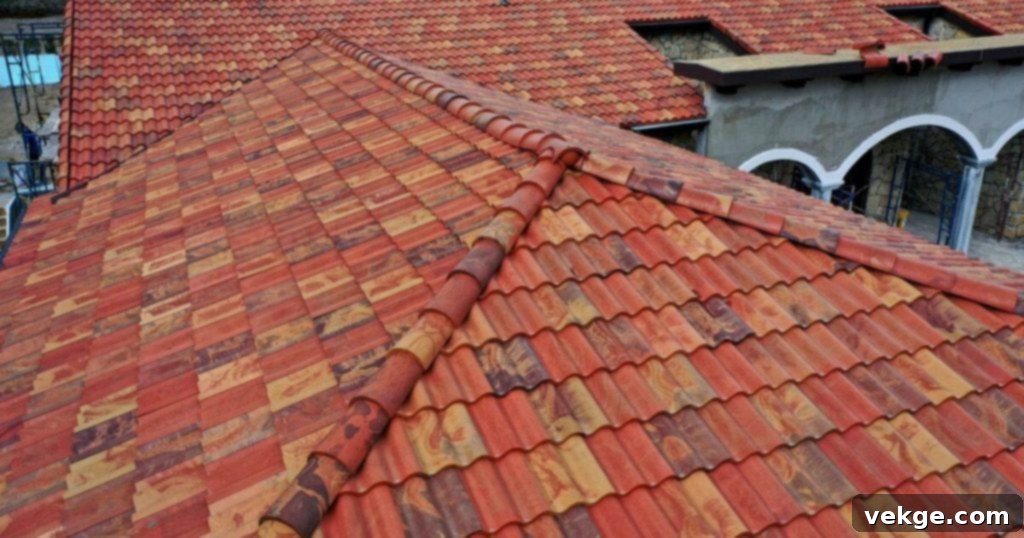
Metal tile roofs beautifully replicate the classic, elegant appearance of traditional clay or concrete tiles without the substantial weight and fragility. Made from various metals like steel or aluminum, these tiles are stamped and coated to mimic the Mediterranean, Spanish, or mission-style aesthetics, offering a durable yet lightweight alternative.
Pros:
- Authentic Aesthetic Appeal: Provides the timeless beauty of traditional tiles, enhancing the architectural character of many homes.
- Significantly Lighter: Much lighter than ceramic or concrete tiles, reducing the load on your home’s structure and potentially lowering installation costs.
- Resilient to Extreme Weather: Offers excellent protection against wind, fire, and impact, often outperforming traditional tiles in harsh conditions.
- Longevity: Expected to last 40-70 years, providing a durable and long-lasting roofing solution.
Cons:
- Higher Cost: More expensive than asphalt shingles and often traditional concrete tiles, though comparable to high-end clay.
- Professional Installation Needed: Specialized installation is crucial to ensure proper interlocking and weather resistance.
- Color Fading: While durable, some coatings may show signs of fading over extended periods, especially in intense sunlight.
Stone-Coated Steel Roofs
Stone-coated steel roofs offer an impressive combination of the strength of steel with the textured beauty of natural stone. These roofs are made from steel panels coated with an acrylic base and then embedded with stone granules, creating a multi-layered barrier that is both highly durable and visually appealing, capable of mimicking shingles, tiles, or wood shakes.
Pros:
- Exceptional Durability: The steel core combined with the stone coating provides outstanding resistance to fire, hail, high winds, and impact.
- Long Lifespan: Can last 40-70 years or more, requiring minimal maintenance throughout its life.
- Versatile Appearance: Available in a wide range of profiles and colors that convincingly imitate other premium roofing materials.
- Sound Dampening: The stone coating helps to muffle noise from rain and hail, providing a quieter indoor environment than other metal roofs.
- Energy Efficient: Reflects solar heat, contributing to lower cooling costs.
Cons:
- Expensive: One of the more premium metal roofing options in terms of initial cost.
- Complex to Install: Requires highly skilled and specialized installers to ensure proper fitting and sealing.
- Weight: Heavier than standard metal shingles, though still significantly lighter than traditional clay or concrete tiles.
Aluminum Roofs
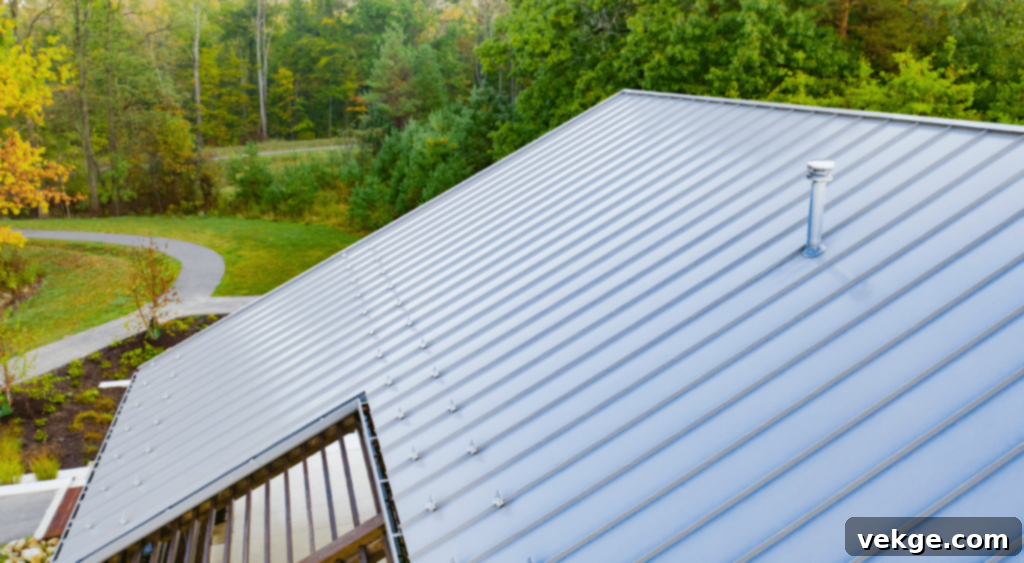
Aluminum roofs are prized for their exceptional lightweight nature and inherent corrosion resistance, making them an ideal choice for coastal regions where saltwater exposure can quickly degrade other metals. Aluminum is naturally reflective, contributing to excellent energy efficiency, and is available in various forms, including standing seam and shingles.
Pros:
- Outstanding Corrosion Resistance: Naturally resistant to rust and corrosion, even without protective coatings, making it perfect for marine environments.
- Extremely Lightweight: Reduces structural demands on your building, making it suitable for a wide range of structures and potentially reducing installation costs.
- Superior Reflective Properties: Excellent at reflecting solar heat, significantly lowering cooling costs and contributing to a cooler indoor environment.
- Durable: Offers a lifespan of 50-70 years with proper care.
- Highly Recyclable: Aluminum is one of the most recycled materials, boasting a high percentage of recycled content.
Cons:
- Can Dent Easily: Aluminum is softer than steel and can be more prone to denting from heavy impacts, like large hail or falling debris.
- Higher Initial Cost: Generally more expensive than steel or corrugated options.
- Limited Color Options: While colors are available, the range might be slightly more limited compared to coated steel products.
- Expansion and Contraction: Aluminum has a higher thermal expansion rate, requiring careful installation techniques to accommodate movement.
Copper Roofs
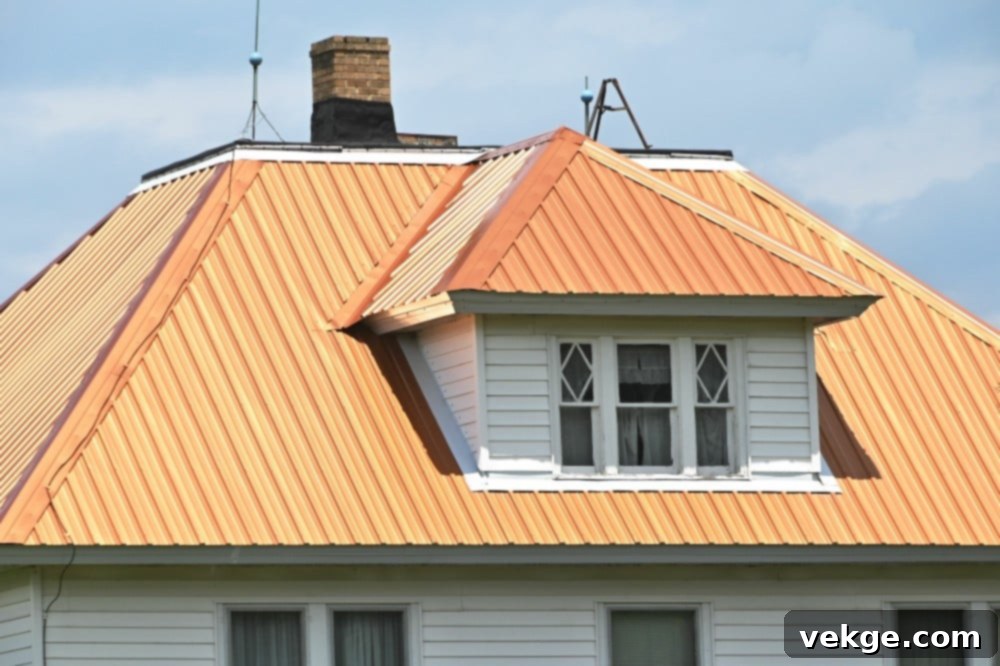
Copper roofs are the epitome of timeless elegance and unparalleled longevity. Known for their distinctive, eye-catching appearance that naturally evolves over time, copper roofs start with a bright, lustrous sheen and gradually develop a beautiful green or blue-green patina. This patina is not only aesthetically pleasing but also forms a protective layer that enhances the metal’s already incredible durability.
Pros:
- Extraordinary Durability: Can last well over 100 years, making it one of the longest-lasting roofing materials available.
- Low Maintenance: Requires virtually no maintenance once installed, thanks to its natural corrosion resistance and protective patina.
- Unique Evolving Aesthetic: The changing patina provides a distinct, classic, and luxurious look that improves with age.
- Excellent Workability: Copper is highly malleable, allowing for complex architectural designs and custom flashing.
- Corrosion Resistance: Naturally resistant to rust and environmental degradation.
Cons:
- Very High Initial Cost: Among the most expensive roofing materials, primarily due to the cost of raw copper and specialized installation.
- Patina Change May Not Be Desirable: The natural aging process and color change may not appeal to everyone and can be a significant aesthetic consideration.
- Requires Expert Installation: Installation requires highly specialized skills and craftsmanship, adding to the overall expense.
- Potential for Staining: Runoff from a copper roof can potentially stain other building materials if not properly managed.
Zinc Roofs
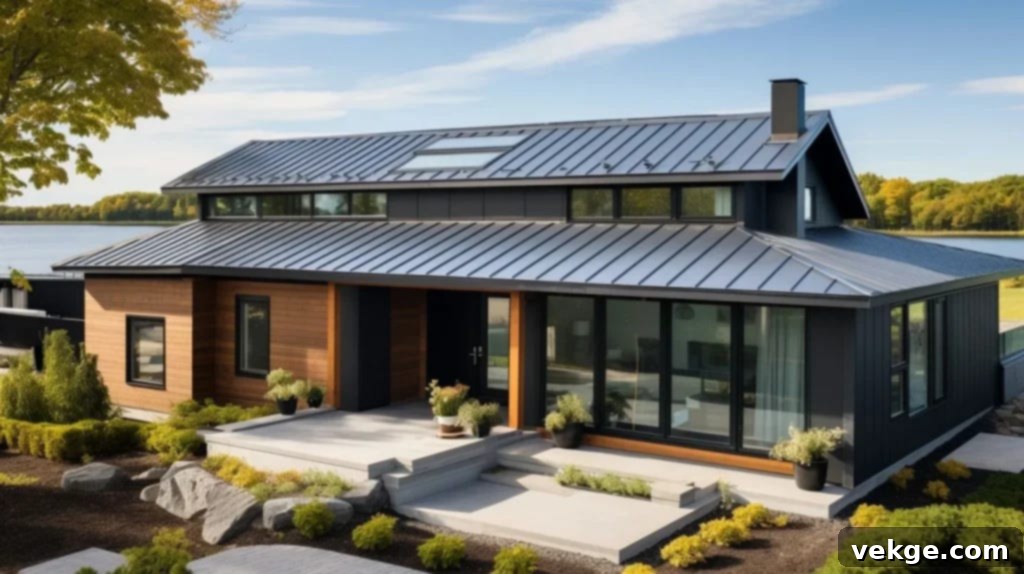
Zinc roofs are highly regarded for their exceptional longevity, environmental friendliness, and unique “self-healing” properties. Like copper, zinc develops a protective patina over time, which not only enhances its durability but can also naturally repair minor scratches and imperfections. This makes zinc an increasingly popular choice for sustainable and architecturally significant projects.
Pros:
- Remarkable Lifespan: Can last 80-100 years or more, offering an incredibly long-term roofing solution.
- Self-Healing Patina: Small scratches and imperfections can naturally “heal” as the patina forms, restoring the roof’s appearance and protection.
- Low Maintenance: Requires minimal maintenance throughout its extensive lifespan.
- Eco-Friendly: Produced with significantly less energy than other metals, highly recyclable, and runoff is non-toxic.
- Malleability: Its flexibility allows for intricate designs and complex architectural details.
Cons:
- Expensive: Similar to copper, zinc has a high initial material and installation cost.
- Limited Availability: May be less readily available than more common metal roofing types, potentially affecting lead times.
- Aesthetic Preference: The evolving grey-blue patina may not suit all aesthetic preferences.
- Oil Canning: Like other flat metal panels, zinc can exhibit oil canning, especially in large, flat sections.
Tin Roofs
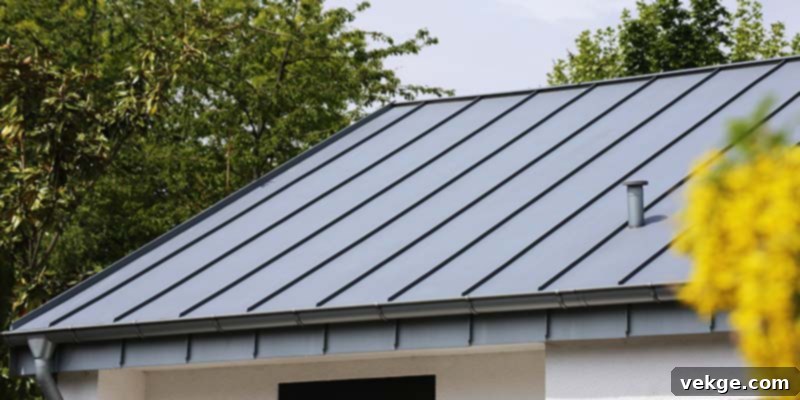
Historically, “tin roofs” often referred to steel sheets coated with tin (terne plate) to prevent rust. While pure tin roofs are rare today, the term is still used colloquially for various metal roofs, especially those with a nostalgic or traditional appeal. Modern interpretations often use galvanized steel with specific coatings to mimic the appearance and offer improved performance, delivering a durable and cost-effective solution for various applications.
Pros:
- Nostalgic and Traditional Appeal: Evokes a classic, historical aesthetic, particularly for restorations or period-appropriate homes.
- Durable: Modern terne-coated steel roofs can offer a lifespan of 30-50 years with proper maintenance and coating.
- Corrosion Resistance: The tin coating provides good protection against rust and environmental elements.
- Lightweight: Generally lightweight, simplifying installation.
Cons:
- Requires Regular Maintenance: Older or less robustly coated tin roofs may require more frequent painting or coating to maintain protection against corrosion.
- Less Energy Efficient: Depending on the finish, they may not offer the same reflective properties as modern “cool roof” metals.
- Can Be Pricier: While cost-effective, specific vintage or custom terne plate options can be more expensive than some modern metal alternatives.
- Susceptible to Denting: Thinner gauge steel can be prone to denting from impact.
Key Considerations When Choosing Your Metal Roof
With an understanding of the different types, it’s time to consider the broader factors that will influence your final decision. Selecting the right metal roof involves balancing performance, aesthetics, budget, and environmental responsibility.
Durability and Longevity
The inherent strength of metal makes it an exceptionally durable roofing material. Most metal roofs are designed to last between 40 to 70 years, with some, like copper and zinc, potentially exceeding a century. Materials such as steel and aluminum are particularly resilient, capable of withstanding severe weather conditions including heavy snow loads, high winds, and even hail impacts. Modern metal roofing often comes with advanced coatings (e.g., Kynar 500) that protect against rust, fading, and chalking, ensuring the roof maintains its integrity and appearance for decades. Always look for robust warranties, as these are a strong indicator of a manufacturer’s confidence in their product’s lifespan.
Environmental Impact
For environmentally conscious property owners, metal roofs are an excellent choice. They are highly sustainable, often containing a significant percentage of recycled content (sometimes up to 95%). Furthermore, metal roofs are 100% recyclable at the end of their extremely long service life, preventing valuable materials from ending up in landfills. Their energy-efficient properties, especially “cool roof” coatings that reflect solar heat, contribute to lower energy consumption and reduced greenhouse gas emissions. This makes metal roofing a choice that benefits both your wallet and the planet.
Cost Comparison
The initial investment for a metal roof can be higher than for traditional asphalt shingles. However, this upfront cost is offset by substantial long-term savings. The price varies significantly based on the metal type, finish, and complexity of installation. Steel and aluminum are generally more affordable than premium options like copper or zinc. While asphalt might cost $3-5 per square foot installed, metal roofs typically range from $8-15 per square foot, with high-end options like copper going up to $20-30 or more. Over its extended lifespan, a metal roof’s minimal maintenance requirements, energy savings, and resistance to damage from weather events result in a much lower total cost of ownership, often making it the more economical choice in the long run.
Aesthetic Appeal
Today’s metal roofs offer an astonishing array of aesthetic possibilities. Gone are the days when metal roofs meant only a corrugated silver sheet. Modern manufacturing techniques allow metal to be formed into diverse profiles that mimic the look of traditional asphalt shingles, elegant slate, rustic wood shakes, or classic clay tiles. A vast spectrum of colors, from subdued earth tones to vibrant hues, along with various finishes (matte, glossy, textured), ensures that there’s a metal roof to perfectly complement any architectural style and enhance your home’s curb appeal. The ability to customize the look ensures your roof is not just functional, but also a key design element.
Installation and Maintenance
Proper installation is paramount for a metal roof’s performance and longevity. Unlike simpler roofing materials, metal roofing requires specialized skills, tools, and experience. It is crucial to hire certified professionals who are experienced in metal roof installation to ensure precise cuts, proper fastening, and effective sealing against leaks. While the initial installation can be more involved, the maintenance requirements for metal roofs are remarkably low. Typically, maintenance involves semi-annual inspections to ensure gutters are clear and there’s no debris accumulation. Unlike asphalt, metal doesn’t require granule replacement, sealing, or frequent repairs, translating to less hassle and cost over the decades.
Partnering with the Right Roofing Company in Indianapolis
Choosing a metal roof is a significant investment that promises decades of protection and aesthetic appeal. To ensure this investment yields the best possible returns, partnering with a reputable and experienced roofing company is essential. For homeowners and businesses in Indianapolis, working with a trusted roofing company in Indianapolis ensures expert advice on material selection, professional installation, and reliable ongoing support. Their local expertise can help you navigate regional weather considerations and building codes, guaranteeing a metal roof that stands the test of time.
Conclusion
Metal roofing presents a compelling option for those seeking a durable, energy-efficient, and aesthetically versatile roofing solution. With nine distinct types, each offering unique benefits and characteristics, there’s a metal roof perfectly suited for every home and architectural vision. By carefully considering factors such as longevity, environmental impact, cost, and aesthetic appeal, and by entrusting your project to a qualified professional, you can make an informed decision that enhances your property’s value and provides superior protection for decades to come.
